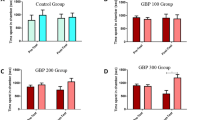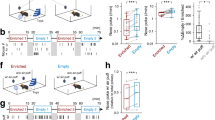Abstract
This protocol describes the equipment and methods used to establish conditioned place preference (CPP) or aversion (CPA). Place conditioning is a form of Pavlovian conditioning routinely used to measure the rewarding or aversive motivational effects of objects or experiences (e.g., abused drugs). Here, we present a place conditioning procedure that has been used extensively to study the motivational effects of ethanol and other abused drugs in mice. This protocol involves three phases: (i) habituation (or a pretest), (ii) conditioning of an association between the drug and a tactile or visual stimulus and (iii) a test that offers a choice between the drug-associated cue and a neutral cue. If the drug has motivational significance, mice will spend significantly more time (CPP) or less time (CPA) in proximity to the drug-associated cue. Potential problems in the design and interpretation of place conditioning studies are discussed. A typical experiment lasts 2 weeks.
This is a preview of subscription content, access via your institution
Access options
Subscribe to this journal
Receive 12 print issues and online access
$259.00 per year
only $21.58 per issue
Buy this article
- Purchase on Springer Link
- Instant access to full article PDF
Prices may be subject to local taxes which are calculated during checkout



Similar content being viewed by others
References
Tzschentke, T.M. Measuring reward with the conditioned place preference paradigm: a comprehensive review of drug effects, recent progress and new issues. Prog. Neurobiol. 56, 613–672 (1998).
Carr, G.D., Fibiger, H.C. & Phillips, A.G. in The Neuropharmacological Basis of Reward (ed. Copper, J.M.L.S.J.) 264–319 (Clarendon Press, Oxford, 1989).
Bardo, M.T. & Bevins, R.A. Conditioned place preference: what does it add to our preclinical understanding of drug reward? Psychopharmacology (Berl.) 153, 31–43 (2000).
Cunningham, C.L., Dickinson, S.D. & Okorn, D.M. Naloxone facilitates extinction but does not affect acquisition or expression of ethanol-induced conditioned place preference. Exp. Clin. Psychopharmacol. 3, 330–343 (1995).
Bevins, R.A. The reference-dose place conditioning procedure yields graded dose–effect function. Int. J. Comp. Psychol. 18, 101–111 (2005).
Bardo, M.T., Rowlett, J.K. & Harris, M.J. Conditioned place preference using opiate and stimulant drugs: a meta-analysis. Neurosci. Biobehav. Rev. 19, 39–51 (1995).
Dworkin, S. & Smith, J. in NIDA Research Monograph (ed. Harris, L.S.) 266–274 (US Department of Health and Human Services, Rockville, MD, 1988).
Everitt, B.J. & Robbins, T.W. Neural systems of reinforcement for drug addiction: from actions to habits to compulsion. Nat. Neurosci. 8, 1481–1489 (2005).
Robinson, T.E. & Berridge, K.C. The neural basis of drug craving: an incentive-sensitization theory of addiction. Brain Res. Rev. 18, 247–291 (1993).
Carr, G.D., Fibiger, H.C. & Phillips, A.G. in The Neuropharmacological basis of Reward (ed. Copper, J.M.L.S.J.) 264–319 (Clarendon Press, Oxford, 1989).
Swerdlow, N.R., Gilbert, D. & Koob, G.F. in Psychopharmacology (Neuromethods Vol. 13) (eds. Boulton, A.A., Baker, G.B. & Greenshaw, A.J.) 399–446 (Humana Press, Clifton, NJ, 1989).
Bechtholt, A.J. & Cunningham, C.L. Ethanol-induced conditioned place preference is expressed through a ventral tegmental area dependent mechanism. Behav. Neurosci. 119, 213–223 (2005).
Robbins, T.W. & Everitt, B.J. Limbic-striatal memory systems and drug addiction. Neurobiol. Learn. Mem. 78, 625–636 (2002).
White, N.M. The role of stimulus ambiguity and movement in spatial navigation: a multiple memory systems analysis of location discrimination. Neurobiol. Learn. Mem. 82, 216–229 (2004).
White, N.M., Chai, S.C. & Hamdani, S. Learning the morphine conditioned cue preference: cue configuration determines effects of lesions. Pharmacol. Biochem. Behav. 81, 786–796 (2005).
Cunningham, C.L., Ferree, N.K. & Howard, M.A. Apparatus bias and place conditioning with ethanol in mice. Psychopharmacology (Berl.) 170, 409–422 (2003).
Bevins, R.A. & Cunningham, C.L. in Tasks and Techniques: A Sampling of Methodologies for the Investigation of Animal Learning, Behavior, and Cognition (ed. Anderson, M.J.) (Nova Science Publishers Inc., Hauppauge, NY, in the press).
Cunningham, C.L., Patel, P.A. & Milner, L.M. Spatial location is critical for conditioning place preference with visual but not tactile stimuli. Behav. Neurosci. 120, 1115–1132 (2006).
Cunningham, C.L., Clemens, J.M. & Fidler, T.L. Injection timing determines whether intragastric ethanol produces conditioned place preference or aversion in mice. Pharmacol. Biochem. Behav. 72, 659–668 (2002).
Cunningham, C.L., Okorn, D.M. & Howard, C.E. Interstimulus interval determines whether ethanol produces conditioned place preference or aversion in mice. Anim. Learn. Behav. 25, 31–42 (1997).
Fudala, P.J. & Iwamoto, E.T. Further studies on nicotine-induced conditioned place preference in the rat. Pharmacol. Biochem. Behav. 25, 1041–1049 (1986).
Fudala, P.J. & Iwamoto, E.T. Conditioned aversion after delay place conditioning with nicotine. Psychopharmacology (Berl.) 92, 376–381 (1987).
Fudala, P.J. & Iwamoto, E.T. Conditioned aversion after delay place conditioning with amphetamine. Pharmacol. Biochem. Behav. 35, 89–92 (1990).
Cunningham, C.L. & Prather, L.K. Conditioning trial duration affects ethanol-induced conditioned place preference in mice. Anim. Learn. Behav. 20, 187–194 (1992).
Cunningham, C.L., Dickinson, S.D., Grahame, N.J., Okorn, D.M. & McMullin, C.S. Genetic differences in cocaine-induced conditioned place preference in mice depend on conditioning trial duration. Psychopharmacology (Berl.) 146, 73–80 (1999).
Cunningham, C.L., Henderson, C.M. & Bormann, N.M. Extinction of ethanol-induced conditioned place preference and conditioned place aversion: effects of naloxone. Psychopharmacology (Berl.) 139, 62–70 (1998).
Cunningham, C.L et al. Ethanol-conditioned place preference is reduced in dopamine D2 receptor-deficient mice. Pharmacol. Biochem. Behav. 67, 693–699 (2000).
Cunningham, C.L., Tull, L.E., Rindal, K.E. & Meyer, P.J. Distal and proximal pre-exposure to ethanol in the place conditioning task: tolerance to aversive effect, sensitization to activating effect, but no change in rewarding effect. Psychopharmacology (Berl.) 160, 414–424 (2002).
Cunningham, C.L., Niehus, D.R., Malott, D.H. & Prather, L.K. Genetic differences in the rewarding and activating effects of morphine and ethanol. Psychopharmacology (Berl.) 107, 385–393 (1992).
Risinger, F.O. & Cunningham, C.L. DBA/2J mice develop stronger lithium chloride-induced conditioned taste and place aversions than C57BL/6J mice. Pharmacol. Biochem. Behav. 67, 17–24 (2000).
Risinger, F.O. & Oakes, R.A. Dose- and conditioning trial-dependent ethanol-induced conditioned place preference in Swiss-Webster mice. Pharmacol. Biochem. Behav. 55, 117–123 (1996).
Cunningham, C.L. Localization of genes influencing ethanol-induced conditioned place preference and locomotor activity in BXD recombinant inbred mice. Psychopharmacology (Berl.) 120, 28–41 (1995).
Cunningham, C.L. et al. Assessment of ethanol's hedonic effects in mice selectively bred for sensitivity to ethanol-induced hypothermia. Psychopharmacology (Berl.) 105, 84–92 (1991).
Risinger, F.O., Malott, D.H., Prather, L.K., Niehus, D.R. & Cunningham, C.L. Motivational properties of ethanol in mice selectively bred for ethanol-induced locomotor differences. Psychopharmacology (Berl.) 116, 207–216 (1994).
Phillips, T.J. et al. Genetic correlational analyses of ethanol reward and aversion phenotypes in short-term selected mouse lines bred for ethanol drinking or ethanol-induced conditioned taste aversion. Behav. Neurosci. 119, 892–910 (2005).
Bechtholt, A.J., Gremel, C.M. & Cunningham, C.L. Handling blocks expression of conditioned place aversion but not conditioned place preference produced by ethanol in mice. Pharmacol. Biochem. Behav. 79, 739–744 (2004).
Boyce-Rustay, J.M. & Risinger, F.O. Dopamine D3 receptor knockout mice and the motivational effects of ethanol. Pharmacol. Biochem. Behav. 75, 373–379 (2003).
Hill, K.G., Alva, H., Blednov, Y.A. & Cunningham, C.L. Reduced ethanol-induced conditioned taste aversion and conditioned place preference in GIRK2 null mutant mice. Psychopharmacology (Berl.) 169, 108–114 (2003).
Risinger, F.O., Freeman, P.A., Greengard, P. & Fienberg, A.A. Motivational effects of ethanol in DARPP-32 knock-out mice. J. Neurosci. 21, 340–348 (2001).
Risinger, F.O., Bormann, N.M. & Oakes, R.A. Reduced sensitivity to ethanol reward, but not ethanol aversion, in mice lacking 5-HT1B receptors. Alcohol Clin. Exp. Res. 20, 1401–1405 (1996).
Vezina, P. & Stewart, J. Conditioned locomotion and place preference elicited by tactile cues paired exclusively with morphine in an open field. Psychopharmacology (Berl.) 91, 375–380 (1987).
Cunningham, C.L. & Noble, D. Methamphetamine-induced conditioned place preference or aversion depending on dose and presence of drug. Ann. NY Acad. Sci. 654, 431–433 (1992).
Cunningham, C.L. in Methods in Behavioral Pharmacology (ed. van Haaren, F.) 349–381 (Elsevier, Amsterdam, 1993).
Mueller, D. & Stewart, J. Cocaine-induced conditioned place preference: reinstatement by priming injections of cocaine after extinction. Behav. Brain Res. 115, 39–47 (2000).
Parker, L.A. & McDonald, R.V. Reinstatement of both a conditioned place preference and a conditioned place aversion with drug primes. Pharmacol. Biochem. Behav. 66, 559–561 (2000).
Vezina, P. & Stewart, J. Morphine conditioned place preference and locomotion: the effect of confinement during training. Psychopharmacology 93, 257–260 (1987).
Acknowledgements
We thank Laura Summers Bax for assistance in data collection. We also thank the many research assistants, graduate students and postdoctoral fellows who contributed to the evolution of our place conditioning model over the last 18 years. Development of this protocol was supported by NIH-NIAAA grants AA007702, AA010760, AA007468 and AA016041.
Author information
Authors and Affiliations
Corresponding author
Ethics declarations
Competing interests
The authors declare no competing financial interests.
Rights and permissions
About this article
Cite this article
Cunningham, C., Gremel, C. & Groblewski, P. Drug-induced conditioned place preference and aversion in mice. Nat Protoc 1, 1662–1670 (2006). https://doi.org/10.1038/nprot.2006.279
Published:
Issue Date:
DOI: https://doi.org/10.1038/nprot.2006.279
This article is cited by
-
GABA release from central amygdala neurotensin neurons differentially modulates ethanol consumption in male and female mice
Neuropsychopharmacology (2024)
-
Advancing preclinical chronic stress models to promote therapeutic discovery for human stress disorders
Neuropsychopharmacology (2024)
-
Robust aversive effects of trace amine-associated receptor 1 activation in mice
Neuropsychopharmacology (2023)
-
Place conditioning in humans: opportunities for translational research
Psychopharmacology (2023)
-
Efficient spatially targeted gene editing using a near-infrared activatable protein-conjugated nanoparticle for brain applications
Nature Communications (2022)
Comments
By submitting a comment you agree to abide by our Terms and Community Guidelines. If you find something abusive or that does not comply with our terms or guidelines please flag it as inappropriate.



